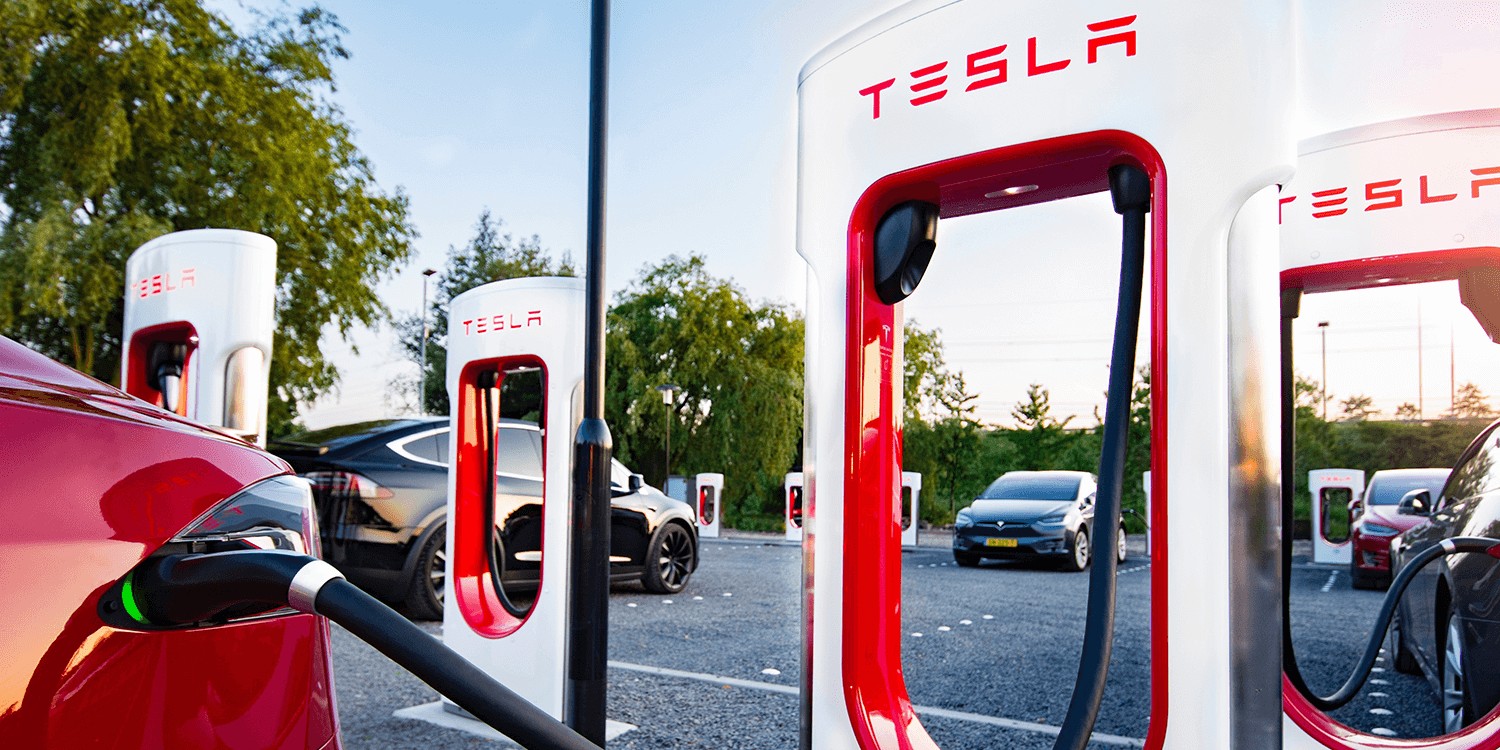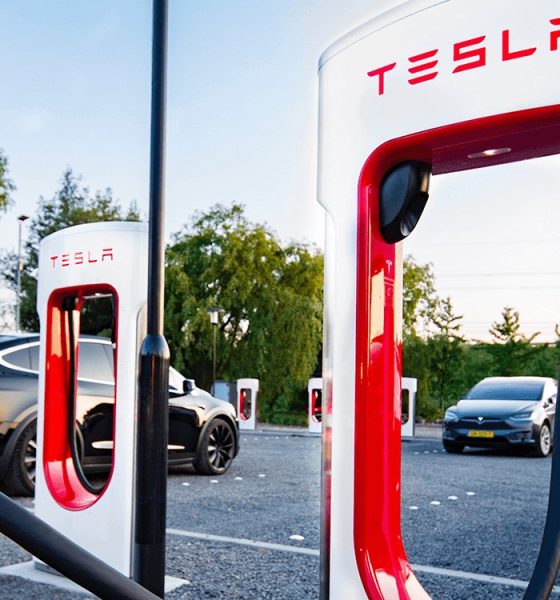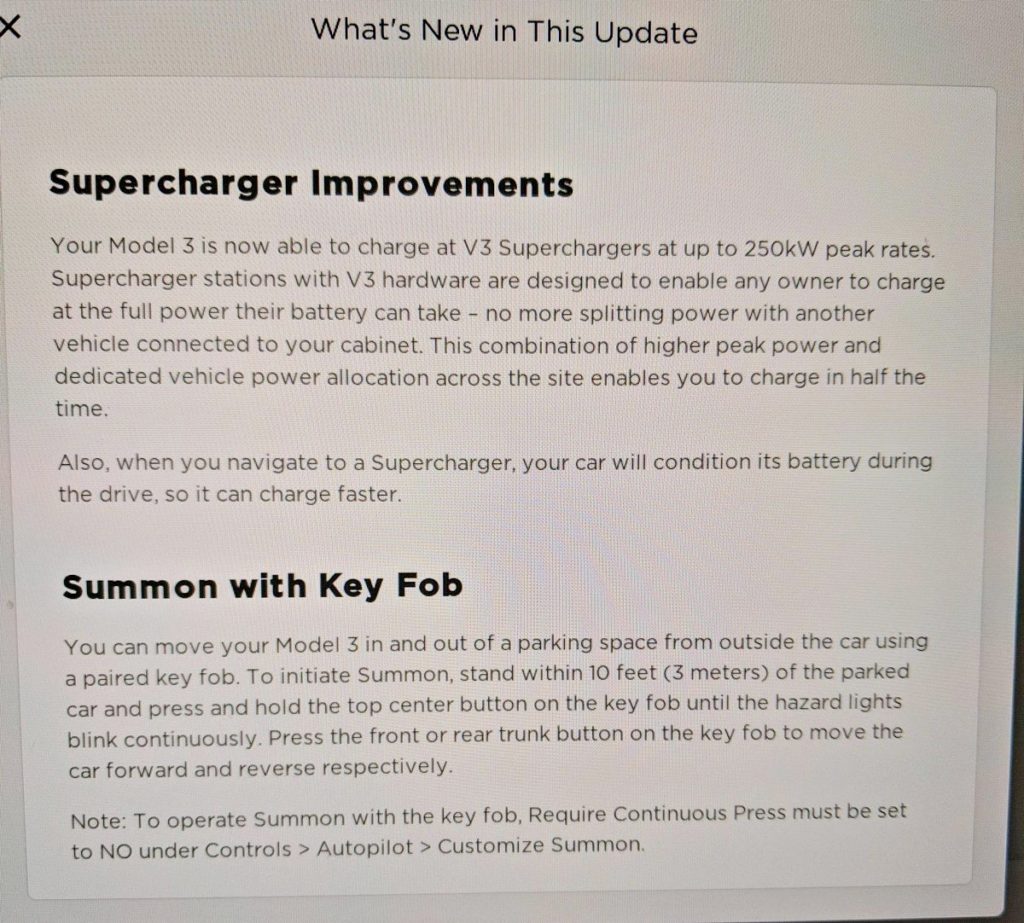

News
Tesla Supercharger V3 details: 250 kW, no charge splitting, twice as fast
Tesla launched its newest V3 Supercharger at an official unveiling event in Fremont, California, Wednesday night.
As we first reported, V3 Superchargers will be able to charge twice as fast the current generation Supercharger with a maximum power output of 250 kW or 1,000 miles per hour. Additionally, Tesla owners using V3 Superchargers will no longer need to split power with neighboring vehicles, thereby substantially increasing the charge rate and reducing the overall amount of charging time by nearly half.
Supercharger V3 details first surfaced Wednesday evening in Release Notes for a new over-the-air firmware update that went out to Model 3 owners, first captured by Erik @teslainventory on Twitter.
Tesla began to roll out the over-the-air firmware update to a small group of Model 3 owners that were invited to attend the official Supercharger V3 unveiling. Attendees are members of Tesla’s “Early Access Program” who will be one of the first to use Tesla’s next-generation Supercharger.
The firmware update went out ahead of the event to prepare these vehicles to accept the higher power output from Tesla’s newest ultra-fast chargers.
“Your Model 3 is now able to charge at V3 Superchargers at up to 250 kW peak rates. Supercharger stations with V3 hardware are designed to enable 
Of note is the final sentence in the section for “Supercharger Improvements”, which indicates that the firmware update will allow a vehicle to condition its batteries before arriving at a V3 Supercharger station. “Also, when you navigate to a Supercharger, your call will condition its battery during the drive, so it can charge faster,” reads the release note.
Preconditioning a battery isn’t something new for Tesla vehicles, especially for P100D owners looking to ‘Bring it on!‘ with Ludicrous Mode. Being able to optimize the temperature of the battery cells allows them to be in a state that can operate at higher current and thereby charge at the higher 250 kW power.
At the moment, our understanding is that only Model 3, which utilizes a newer generation 2170 cell compared to the older 18650 form factor cell found in Model S and Model X, will be able to V3 Supercharge at full potential.
Be sure to check back as we will update the story with full details and specifications for Tesla Supercharger V3.
Update: Tesla published details for V3 Supercharging in a company blog post (included below). A video of the fast charging speed can be seen in their video.
Introducing V3 Supercharging
Tesla has more than 12,000 Superchargers across North America, Europe, and Asia and our network continues to grow daily: more than 99% of the U.S. population is covered by the network, and we anticipate similar coverage in Europe by the end of 2019. Recently, we passed 90% population coverage in China and are growing that number quickly. However, in order to drive continued electric vehicle adoption and further accelerate the world’s transition to sustainable energy, charging needs to be even faster, and the number of vehicles able to charge at a location in a day needs to be significantly higher. Today, we’re unveiling V3 Supercharging, the next step in the growth of Tesla’s Supercharger network. V3, which is born from our experience building the world’s largest grid-connected batteries, enables our vehicles to charge faster than any other electric vehicle on the market today.
Faster Charging, No More Power Sharing
V3 is a completely new architecture for Supercharging. A new 1MW power cabinet with a similar design to our utility-scale products supports peak rates of up to 250kW per car. At this rate, a Model 3 Long Range operating at peak efficiency can recover up to 75 miles of charge in 5 minutes and charge at rates of up to 1,000 miles per hour. Combined with other improvements we’re announcing today, V3 Supercharging will ultimately cut the amount of time customers spend charging by an average of 50%, as modeled on our fleet data.
Supercharger stations with V3’s new power electronics are designed to enable any owner to charge at the full power their battery can take – no more splitting power with a vehicle in the stall next to you. With these significant technical improvements, we anticipate the typical charging time at a V3 Supercharger will drop to around 15 minutes.
On-Route Battery Warmup
New Supercharging infrastructure isn’t the only way we are improving our customers’ charging experience. Beginning this week, Tesla is rolling out a new feature called On-Route Battery Warmup. Now, whenever you navigate to a Supercharger station, your vehicle will intelligently heat the battery to ensure you arrive at the optimal temperature to charge, reducing average charge times for owners by 25%.
This combination of higher peak power with V3, dedicated vehicle power allocation across Supercharger sites, and On-Route Battery Warmup 
With Model 3 now shipping globally in high volumes and Model Y on the way, V3 Supercharging enables us to deliver the fastest production charging experience at an unprecedented scale compared to other electric vehicle manufacturers. By increasing the number of vehicles we’re able to charge at each Supercharger in a day, the investment we’re making in our network will go significantly further with every V3 station deployed. Paired with other savings, these efficiencies will translate to an increased pace of investment for Superchargers moving forward, with a continued focus on getting to 100% ownership coverage across all regions we operate. With thousands of new Superchargers coming online in 2019, the launch of V3, and other changes we’re making to improve throughput, the Supercharger network will be able to serve more than 2x more vehicles per day at the end of 2019 compared with today – easily keeping pace with our 2019 fleet growth.
Beginning today, we’re opening the first public beta site in the Bay Area, which will incrementally be made available to owners in Tesla’s Early Access Program. We’re launching V3 Supercharging for Model 3, our highest volume vehicle, and we’ll continue to expand access as we review and assess the results of millions of charging events. We will increase Model S and X charging speeds via software updates in the coming months. V3 Supercharging will roll out to the wider fleet in an over the air firmware update to all owners in Q2 as more V3 Superchargers come online. Our first non-beta V3 Supercharger site will break ground next month, with North American sites ramping in Q2 and Q3 before coming to Europe and Asia-Pacific in Q4.

News
Nvidia CEO Jensen Huang explains difference between Tesla FSD and Alpamayo
“Tesla’s FSD stack is completely world-class,” the Nvidia CEO said.

NVIDIA CEO Jensen Huang has offered high praise for Tesla’s Full Self-Driving (FSD) system during a Q&A at CES 2026, calling it “world-class” and “state-of-the-art” in design, training, and performance.
More importantly, he also shared some insights about the key differences between FSD and Nvidia’s recently announced Alpamayo system.
Jensen Huang’s praise for Tesla FSD
Nvidia made headlines at CES following its announcement of Alpamayo, which uses artificial intelligence to accelerate the development of autonomous driving solutions. Due to its focus on AI, many started speculating that Alpamayo would be a direct rival to FSD. This was somewhat addressed by Elon Musk, who predicted that “they will find that it’s easy to get to 99% and then super hard to solve the long tail of the distribution.”
During his Q&A, Nvidia CEO Jensen Huang was asked about the difference between FSD and Alpamayo. His response was extensive:
“Tesla’s FSD stack is completely world-class. They’ve been working on it for quite some time. It’s world-class not only in the number of miles it’s accumulated, but in the way it’s designed, the way they do training, data collection, curation, synthetic data generation, and all of their simulation technologies.
“Of course, the latest generation is end-to-end Full Self-Driving—meaning it’s one large model trained end to end. And so… Elon’s AD system is, in every way, 100% state-of-the-art. I’m really quite impressed by the technology. I have it, and I drive it in our house, and it works incredibly well,” the Nvidia CEO said.
Nvidia’s platform approach vs Tesla’s integration
Huang also stated that Nvidia’s Alpamayo system was built around a fundamentally different philosophy from Tesla’s. Rather than developing self-driving cars itself, Nvidia supplies the full autonomous technology stack for other companies to use.
“Nvidia doesn’t build self-driving cars. We build the full stack so others can,” Huang said, explaining that Nvidia provides separate systems for training, simulation, and in-vehicle computing, all supported by shared software.
He added that customers can adopt as much or as little of the platform as they need, noting that Nvidia works across the industry, including with Tesla on training systems and companies like Waymo, XPeng, and Nuro on vehicle computing.
“So our system is really quite pervasive because we’re a technology platform provider. That’s the primary difference. There’s no question in our mind that, of the billion cars on the road today, in another 10 years’ time, hundreds of millions of them will have great autonomous capability. This is likely one of the largest, fastest-growing technology industries over the next decade.”
He also emphasized Nvidia’s open approach, saying the company open-sources its models and helps partners train their own systems. “We’re not a self-driving car company. We’re enabling the autonomous industry,” Huang said.
Elon Musk
Elon Musk confirms xAI’s purchase of five 380 MW natural gas turbines
The deal, which was confirmed by Musk on X, highlights xAI’s effort to aggressively scale its operations.

xAI, Elon Musk’s artificial intelligence startup, has purchased five additional 380 MW natural gas turbines from South Korea’s Doosan Enerbility to power its growing supercomputer clusters.
The deal, which was confirmed by Musk on X, highlights xAI’s effort to aggressively scale its operations.
xAI’s turbine deal details
News of xAI’s new turbines was shared on social media platform X, with user @SemiAnalysis_ stating that the turbines were produced by South Korea’s Doosan Enerbility. As noted in an Asian Business Daily report, Doosan Enerbility announced last October that it signed a contract to supply two 380 MW gas turbines for a major U.S. tech company. Doosan later noted in December that it secured an order for three more 380 MW gas turbines.
As per the X user, the gas turbines would power an additional 600,000+ GB200 NVL72 equivalent size cluster. This should make xAI’s facilities among the largest in the world. In a reply, Elon Musk confirmed that xAI did purchase the turbines. “True,” Musk wrote in a post on X.
xAI’s ambitions
Recent reports have indicated that xAI closed an upsized $20 billion Series E funding round, exceeding the initial $15 billion target to fuel rapid infrastructure scaling and AI product development. The funding, as per the AI startup, “will accelerate our world-leading infrastructure buildout, enable the rapid development and deployment of transformative AI products.”
The company also teased the rollout of its upcoming frontier AI model. “Looking ahead, Grok 5 is currently in training, and we are focused on launching innovative new consumer and enterprise products that harness the power of Grok, Colossus, and 𝕏 to transform how we live, work, and play,” xAI wrote in a post on its website.
Elon Musk
Elon Musk’s xAI closes upsized $20B Series E funding round
xAI announced the investment round in a post on its official website.

xAI has closed an upsized $20 billion Series E funding round, exceeding the initial $15 billion target to fuel rapid infrastructure scaling and AI product development.
xAI announced the investment round in a post on its official website.
A $20 billion Series E round
As noted by the artificial intelligence startup in its post, the Series E funding round attracted a diverse group of investors, including Valor Equity Partners, Stepstone Group, Fidelity Management & Research Company, Qatar Investment Authority, MGX, and Baron Capital Group, among others.
Strategic partners NVIDIA and Cisco Investments also continued support for building the world’s largest GPU clusters.
As xAI stated, “This financing will accelerate our world-leading infrastructure buildout, enable the rapid development and deployment of transformative AI products reaching billions of users, and fuel groundbreaking research advancing xAI’s core mission: Understanding the Universe.”
xAI’s core mission
Th Series E funding builds on xAI’s previous rounds, powering Grok advancements and massive compute expansions like the Memphis supercluster. The upsized demand reflects growing recognition of xAI’s potential in frontier AI.
xAI also highlighted several of its breakthroughs in 2025, from the buildout of Colossus I and II, which ended with over 1 million H100 GPU equivalents, and the rollout of the Grok 4 Series, Grok Voice, and Grok Imagine, among others. The company also confirmed that work is already underway to train the flagship large language model’s next iteration, Grok 5.
“Looking ahead, Grok 5 is currently in training, and we are focused on launching innovative new consumer and enterprise products that harness the power of Grok, Colossus, and 𝕏 to transform how we live, work, and play,” xAI wrote.








